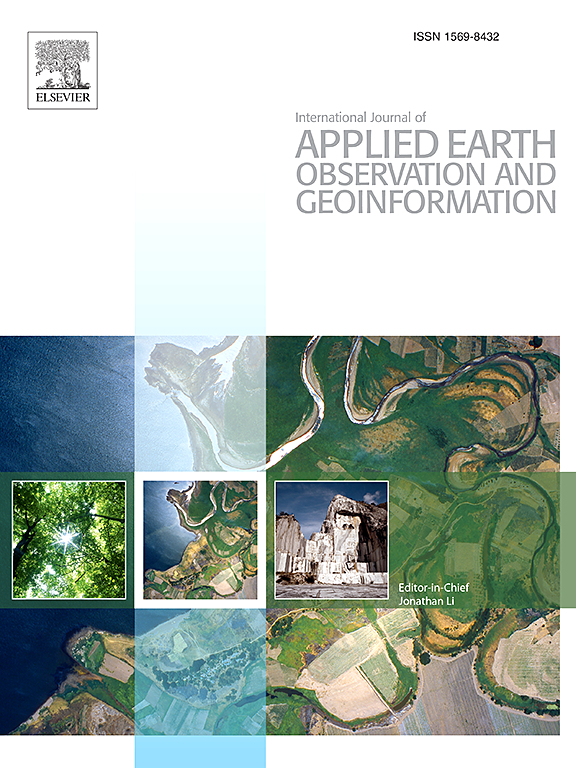Sentinel-2和Sentinel-1堆肥和消化物扩散的农场尺度制图
IF 7.6
Q1 REMOTE SENSING
International journal of applied earth observation and geoinformation : ITC journal
Pub Date : 2025-04-25
DOI:10.1016/j.jag.2025.104555
引用次数: 0
摘要
根据最近的一些研究,利用光学和雷达遥感技术可以在新兴植被或裸露土壤上检测到外源有机质(EOM)。然而,这些图像处理方法只考虑一个单一的EOM,一个季节和/或一年,并且仅限于扩散前的一个表面条件。到目前为止,还没有一种方法可以利用卫星图像同时跟踪不同年份、季节和地表条件下的液体和固体EOM应用。依托支持向量机(SVM)分类器,本研究旨在跟踪连续三年(2019年冬末;在具有不同表面条件(草地,冬季作物,裸露土壤)的农场规模的农业领域(2020年和2021年春季)。基于观测到的改良实践、作物和土壤图,圈定田内参考区域,并随机选择替代区域,通过多次迭代训练/验证SVM。由来自Sentinel-2和/或Sentinel-1数据的波段、信号和特定光谱指数组成的各种特征集用于以自举方法计算SVM,从而产生一系列地图结果,以评估最终模式类别和地图结果的不确定性。与单独使用应用后图像相比,应用前和应用后图像对的分类性能更高,并且在添加Sentinel-1数据时略有提高。尽管无论年份如何,最高不确定性类别的面积百分比覆盖的地图面积不到10%,但最佳模型在2020年和2021年的准确性高于93%。2019年,整体精度未达到79%以上,可能是由于降雨事件和图像对之间的相当大的时间滞后。这项研究不仅强调了Sentinel-2和1在监测EOM应用方面的潜力,而且还强调了更好地理解EOM传播的光谱行为的需求,与作物技术管理序列的全面表征一致。本文章由计算机程序翻译,如有差异,请以英文原文为准。

Farm-scale mapping of compost and digestate spreadings from Sentinel-2 and Sentinel-1
According to few recent studies, exogenous organic matters (EOM) can be detectable on either emerging vegetation or bare soil using optical and radar remote sensing techniques. Nevertheless, these image processing approaches considered one single EOM, one season and/or year only and were limited to one surface condition prior to spreading. So far no method addressed the simultaneously tracking of both liquid and solid EOM applications using satellite imagery, for different years, seasons and surface conditions. Relying on Support Vector Machine (SVM) classifier, this study aimed to track applications of both composted manure and liquid digestate over three seasons of successive years (late winter of 2019; spring of 2020 and 2021) in agricultural fields on a farm scale with distinct surface conditions (grassland, winter crop, bare soil). Within-field reference areas were delineated based on both the observed amendment practices, crops and soil map and randomly selected with replacement to train/ validate SVM with several iterations. Various feature sets composed of bands, signals and specific spectral indices from either Sentinel-2 and/or Sentinel-1 data served to compute SVM in a bootstrapping approach in order to produce a series of map results, to assess the final mode class and the uncertainty of map results. Classification performance was higher for pre- and post-application image pairs compared to post-application images alone and slightly improved when adding Sentinel-1 data. While the areal percentage of the highest uncertainty class covered less of 10% of the mapped area regardless of the year, the best models showed accuracies higher than 93% in 2020 and 2021. In 2019, the overall accuracy did not reach more than 79%, probably due to rainfall events and considerable time lags between the image pairs. This study underscores, not only the potential of Sentinel-2 and 1 for monitoring EOM applications, but also the requirement of better understanding the spectral behaviour of the EOM spreadings, in line with a thorough characterization of the sequence of crop technical management.
求助全文
通过发布文献求助,成功后即可免费获取论文全文。
去求助
来源期刊

International journal of applied earth observation and geoinformation : ITC journal
Global and Planetary Change, Management, Monitoring, Policy and Law, Earth-Surface Processes, Computers in Earth Sciences
CiteScore
12.00
自引率
0.00%
发文量
0
审稿时长
77 days
期刊介绍:
The International Journal of Applied Earth Observation and Geoinformation publishes original papers that utilize earth observation data for natural resource and environmental inventory and management. These data primarily originate from remote sensing platforms, including satellites and aircraft, supplemented by surface and subsurface measurements. Addressing natural resources such as forests, agricultural land, soils, and water, as well as environmental concerns like biodiversity, land degradation, and hazards, the journal explores conceptual and data-driven approaches. It covers geoinformation themes like capturing, databasing, visualization, interpretation, data quality, and spatial uncertainty.
 求助内容:
求助内容: 应助结果提醒方式:
应助结果提醒方式:


